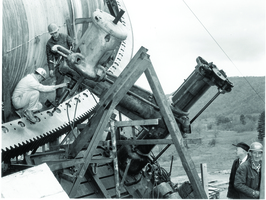 | Back to e-WV
| Back to e-WV
 The West Virginia Encyclopedia
The West Virginia Encyclopedia
 | Back to e-WV
| Back to e-WV
 The West Virginia Encyclopedia
The West Virginia Encyclopedia

The National Radio Astronomy Observatory (NRAO), funded by the National Science Foundation and operated by Associated Universities, Inc., is located near Green Bank in Pocahontas County. Radio astronomy differs from visual astronomy in that the dish-shaped telescopes gather radio waves rather than light waves. The Green Bank site was chosen in 1955 for its surrounding mountains, which shield it from radio interference, and its low population and lack of industrial development. A 13,000 square mile National Radio Quiet Zone was established when construction began at Green Bank in 1958, and the first radio telescopes were in operation by fall 1959. Today the NRAO provides free access to its research equipment to scientists from all over the world.
Green Bank’s 140-foot telescope, the world’s largest equatorially mounted radio telescope, operates at short wavelengths. The Interferometer, a series of 85-foot telescopes, operated at Green Bank for the U.S. Naval Observatory from 1964 until 1996. A 300-foot meridian transit telescope began observations in October 1961 and operated until it collapsed in 1988. Its replacement, the Robert C. Byrd Green Bank Telescope, the world’s largest fully steerable radio telescope, was dedicated on August 25, 2000. The 16-million-pound telescope’s surface dimensions are 100 meters by 110 meters. It can be pointed with an accuracy of one arcsecond, equivalent to the width of a human hair seen from six feet away. The 2,004 panels that make up the telescope’s surface are mounted at their corners on actuators, little motor-driven pistons, which make it easier to adjust the shape of the surface.
The NASA Search for Extraterrestrial Intelligence began at the NRAO in April 1960, when astronomer Frank Drake began Project Ozma, using the 85-foot Tatel telescope that is sensitive enough to detect routine radio signals such as we produce on Earth. The SETI project continued until it lost congressional support in 1993. In 1995, the search was revived in Project Phoenix, privately supported and based in Australia but also using the 140-foot telescope in Green Bank from September 1996 until April 1998, for the focus on northern stars with planets.
In January 2016, Project Breakthrough Listen began using the 300 foot Green Bank Telescope to search 200 stars nearest to earth for radio emissions that might indicate intelligent life. The project is a 10 year, $100 million initiative by Russian billionaire Yuri Milner and cosmologist Stephen Hawking. The project will use 20% of the telescope’s observation time and bring $20 million to the Green Bank Observatory over the next decade.
The Reber Telescope was designated a National Historic Landmark in 1989. The Reber telescope is the original parabolic 31.4-foot antenna built by Grote Reber in 1937 and moved to Green Bank in 1959–60. It is on display there with a replica of the original Jansky antenna built by Karl G. Jansky, the originator of radio astronomy, and the Ewen-Purcell Horn Antenna.
In late 2020, thanks to a National Science Foundation grant to study Fast Radio Bursts, it was announced that a 60-meter-long, 20-meter-wide “outrigger” telescope will be built at NRAO. It will operate in concert with similar Outrigger telescopes to be built in British Columbia and Ontario, Canada. The three telescopes will assist the larger Canadian Hydrogen Intensity Mapping Experiment (CHIME) telescope in British Columbia to pinpoint FRBs for observation.
e-WV presents West Virginia Public Broadcasting on National Radio Astronomy Observatory
Written by Louise Burner Flegel
Pocahontas County Historical Society. History of Pocahontas County. Marlinton: 1981.
Information About the National Radio Astronomy Observatory. Charlottesville: National Radio Astronomy Observatory.